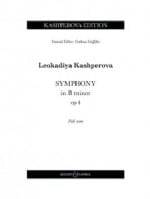Kashperova, Leokadiya - Symphony in B minor op 4 (Score)
Leokadiya Kashperova (1872–1940), hitherto consigned to a footnote in musical history as Stravinsky’s piano teacher, is undergoing rediscovery. A double graduate of the St Petersburg Conservatoire, she emerged as a virtuoso pianist and composer in the romantic tradition. She was associated with some of the great musicians of her day, including Balakirev and Auer. She performed in both Germany and the UK in the 1900s, but her career petered out after 1920.
The Symphony in B minor of 1905 is Kashperova’s grandest composition. Testimony to her originality is that the work betrays her sympathies not only for the Russian symphonic tradition but also that of central Europe. Indeed, upon hearing the work one commentator has likened the experience to being transported down the Danube and up the Rhine. In the Symphony her instinct for instrumental timbre and subtle combinations extends to every section of the orchestra. The work abounds in felicitous solos for woodwinds and brass, and it reveals many effective and original ‘chamber ensembles’ from within the symphonic palette, the first movement’s cello solo to the accompaniment of horn quartet being a memorable example. Equally notable is Kashperova’s exploitation of the extremities of register, which is also a characteristic of the piano writing in her chamber music and art-songs. In the slow introduction, the violins reach higher than one expects at such an early moment, with delightfully expressive results; whilst the Andante’s closing bars plunge ever deeper, possibly reflecting the impact of the final bars of Tchaikovsky’s Pathétique. Yet, Kashperova’s uplifting Finale (Molto allegro) emphatically does not follow this script. On the contrary, the modest ‘folk tune’ (Andante sostenuto) which heralds this final journey is transformed in the closing bars into triumphant life-assertion. The whole orchestra, as it were, lights up the vast sky of the Russian hinterland in a sustained and iridescent sunset of blazing colour and majesty.

